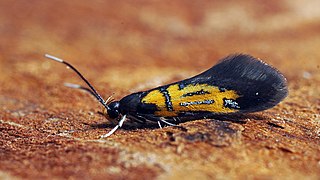
The Coleophoridae are a family of small moths, belonging to the huge superfamily Gelechioidea. Collectively known as case-bearers, casebearing moths or case moths, this family is represented on all continents, but the majority are found in temperate areas of the Northern Hemisphere. They are most common in the Palearctic, and rare in sub-Saharan Africa, South America, and Australia; consequently, they probably originated in northern Eurasia. They are relatively common in houses, they seek out moist areas to rest and procreate.

Melitaea is a genus of brush-footed butterflies. They are here placed in the tribe Melitaeini of subfamily Nymphalinae; some authors elevate this tribe to subfamily rank.

Acompsia is a genus of the twirler moth family (Gelechiidae). Though it has once been assigned to the proposed subfamily "Anacampsinae", it is generally placed in the Dichomeridinae. Some authors include Telephila here as a subgenus, while others prefer to keep it distinct as its relationships are fairly obscure.

Bryotropha is a genus of the twirler moth family (Gelechiidae). Among these, it is placed in the tribe Anomologini of subfamily Gelechiinae; the tribe was formerly considered a distinct subfamily Anomologinae.

Pseudatemelia flavifrontella is a species of gelechioid moths.
Aethiopodes are a genus in the geometer moth family (Geometridae). Sometimes included in Odontopera, other authors treat it as distinct. If valid, it is a small genus with just about 10 species from southern Africa.

Drepanogynis is a genus in the geometer moth family (Geometridae). Long considered to hold about 5 dozen species, this number has been doubled after the last major revision. They are stout-bodied and hairy by geometer moth standards, usually have pale hindwings and rest with their wings angled upwards like a roof, as Nacophorini do. The genus is by and large restricted to Africa south of the Equator, with most species occurring in southern Africa.

Ectropis is a genus in the geometer moth family (Geometridae). They are mostly paleotropical, but also plentiful in Australia and extend into Asia. Only one species – or cryptic species complex – is found in Europe. There are about 100 known species in this genus.

Entephria is a genus in the geometer moth family (Geometridae). There is no unambiguous common name for these moths; like many other members of their subfamily Larentiinae, they are sometimes called "carpets". The genus was erected by Jacob Hübner in 1825.

Erannis is a genus of geometer moths in the subfamily Ennominae erected by Jacob Hübner in 1825. It is placed by some entomologists in the tribe Erannini as the type genus, but others merge this group into the tribe Boarmiini or Bistonini.

Gnophos is a genus in the geometer moth family (Geometridae). A mostly Old World lineage, it is abundant in the Palearctic, with some North American species as well; in Europe six species are recorded. This genus has about 120 known species altogether in several recognized subgenera, with new ones still being discovered occasionally.

Orthonama is a genus of the geometer moth family (Geometridae). It belongs to the tribe Xanthorhoini of the "carpet" subfamily (Larentiinae). Nycterosea is usually included here by modern authors, but may in fact be distinct enough to warrant recognition as an independent genus. The genus was erected by Jacob Hübner in 1825.
Piercia is a genus in the geometer moth family (Geometridae). It belongs to subfamily Larentiinae, but therein its relationships are fairly obscure. About 10 species occur in southern and eastern Asia, but most – almost 50 as of 2005 – are found in Africa.
Prosomphax is a very small genus in the geometer moth family (Geometridae). As of 2005, only four species had been described; all are found in the southern half of Africa. This little-studied genus belongs to the emerald moth subfamily (Geometrinae), but beyond that its relationships are still rather obscure.

Nemaxera is a genus of the fungus moth family, Tineidae. Therein, it belongs to the subfamily Nemapogoninae. The genus is considered monotypic, with the single species Nemaxera betulinella placed here.

Esperia is a genus of the concealer moth family (Oecophoridae). Among these, it belongs to subfamily Oecophorinae. Most authors include Dasycera here, though approaches that generally follow a "splitting" approach sometimes do not.

Schiffermuelleria is a genus of gelechioid moths. It is placed in the subfamily Oecophorinae of family Oecophoridae. The genus is treated as monotypic, with the single species Schiffermuelleria schaefferella placed here. As such, its distinctness from the closely related genus Borkhausenia – where S. schaefferella was often placed in the past – is open to debate.

Parectropis similaria, the brindled white-spot, is a moth of the family Geometridae. The species was first described by Johann Siegfried Hufnagel in 1767. It is found in most of Europe.

Luquetia is a moth genus of the superfamily Gelechioidea described by Patrice J.A. Leraut in 1991. It is mostly placed in the family Depressariidae, which is often – particularly in older treatments – considered a subfamily of the Oecophoridae or included in the Elachistidae.

Semioscopis is a moth genus of the superfamily Gelechioidea. It is placed in the subfamily Depressariinae.















